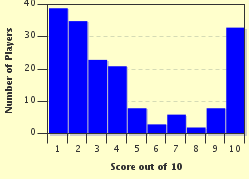Quiz Answer Key and Fun Facts
1. The hypothetical Altaic language macrofamily includes several extant Eurasian language families. Which of these is NOT considered part of Altaic?
2. Spoken mostly on the western side of the France/Spain border, Basque has been attached to countless proposed language families, but none of these connections has stood on solid theoretical ground. One proposed linguistic connection to Basque does seem theoretically sound, however. To which ancient language does Basque seem to be genetically related?
3. The Dravidian languages, spoken primarily in southern India and Sri Lanka, are part of which larger language family?
4. The Kalmuck language is spoken in Russia's Republic of Kalmykia, between the Volga and Don rivers. This is unusual because Kalmuck is a member of which geographically-distant language family?
5. Linguist Hannu Hakola has proposed a language macro-family, based largely on the fact that all of the language families within it are agglutinative. What is the name of Hakola's proposed macro-family?
6. Once considered to be an isolate language with two divergent dialects (Tundra and Kolyma), which of these is now considered to be a pair of separate languages, all that remain of a once-larger family?
7. The Na-Dené family of North America was once considered a viable language family. Its status has been called into question in recent decades, however, with one language's family membership being a source of particular contention. Which language's membership in Na-Dené has been considered controversial?
8. Click consonants may be found in several language families in Africa; the !Xóõ language has as many as five types of clicks (Miller, 2010). Which of these language families does NOT contain a click-consonant language?
9. Although true numbers are difficult to assess and may vary from researcher to researcher, which language family is widely considered to have the largest number of distinct languages?
10. Guaraní is an official language of Paraguay, but is also unusual for being spoken by a vast majority of Paraguay's population; it is the only indigenous language of the Americas that is spoken by a majority of non-indigenous people (NYT, 3/12/12). To which language family does Guaraní belong?
Source: Author
Sapir
This quiz was reviewed by FunTrivia editor
looney_tunes before going online.
Any errors found in FunTrivia content are routinely corrected through our feedback system.

